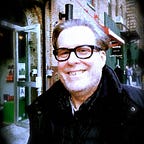How many megapixels does it take to shoot a great photograph?
Does technology help or hinder creativity?
Over a cup of coffee in the park, I talked this over with a friend of mine who’s a long time pro-photographer. He likes talking cameras. Me too. I asked this: I have an expensive Sony camera that deploys 40 megapixels, but I find myself still shooting a lot with my iPhone.
It’s convenient, he says. Yeah, there’s that. I always have my phone on me. But it’s more than that. I get a certain type of photo I can’t get with my other cameras.
A certain unexpected immediacy.
A quick impression.
An evocative light.
Mostly, the great Henri Cartier-Bresson worked with the simplest of cameras.
To me, photography is the simultaneous recognition, in a fraction of a second, of the significance of an event.
Photographers deal in things which are continually vanishing and when they have vanished there is no contrivance on earth which can make them come back again.
The photograph itself doesn’t interest me. I want only to capture a minute part of reality. Cartier-Bresson
Creativity itself works that way. It’s not about capturing the whole of existence. It’s about capturing the purest essence of reality and distilling it into a single drop. And what does it take to do that?
A single guitar can play a simple melody and capture an entire universe of emotion. An 80 piece orchestra can do the same thing.
It’s not the tool; it’s the feeling.
An artist strives for expression. When the expression is there the artist’s job is complete, but sometimes the hardest thing to know is when a work of art is done. But that’s the answer: When you see the feeling fully expressed.
Technology can separate you from your creativity, or color it in ways that mask the essence of what you’re trying to say. Usually, that happens when two things occur: Either you’ve chosen the wrong tool for the job. Or you’re idea was not in focus before you began.
Technology makes it easy to begin. But the beginning is the easiest part of a creative project. It’s the way you end that makes the difference. Unless you want to get caught in an endless spiral of revisions, you must have your idea formed before you begin.
There are exceptions to that. A process can you lead to a result. But that’s rare. The great works of art, and they are few, are usually fully formed in the artist’s mind before they begin. Whether it’s a novel or a film or a painting this often proves true.
Think about it: How many times have you heard an artist discuss a masterpiece and they say they had the whole story, the complete design, the final goal in mind; it came to them in one piece.
JK Rowing conceived of a seven-novel series on a single train ride. The Sydney Opera House was drawn on a napkin over lunch. Fully formed masterpieces. It doesn’t take a single megapixel to make a great photograph. It takes an artist’s unique vision. Without the artist’s touch, no technology alone can ever capture the essence of truth in the same way.
